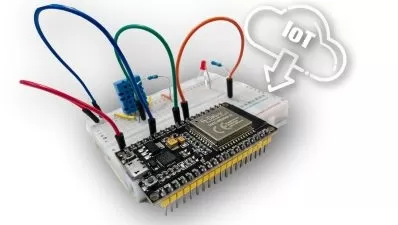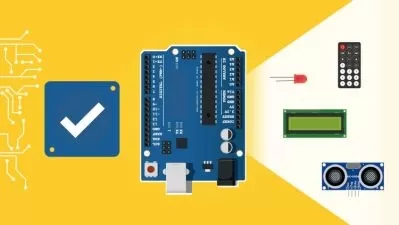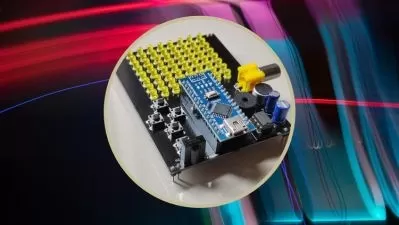The Ultimate Node-RED Programming for Electronics DIY
1:54:21
Description
Design IoT Projects with Raspberry Pi, Arduino, and ESP32
What You'll Learn?
- Understand the basics of Node-RED, its visual programming interface, and how it simplifies IoT application development.
- Learn how to install and set up Node-RED on Raspberry Pi, Arduino, and ESP32.
- Explore flow-based programming concepts.
- Build flows by connecting nodes to create automation logic.
- Connect Raspberry Pi, Arduino, and ESP32 devices to Node-RED.
- Learn how to read sensor data (e.g., temperature, humidity) and control actuators (e.g., LEDs, motors).
- Understand MQTT, HTTP, and other communication protocols, Implement MQTT-based communication between devices and Node-RED.
- Design interactive dashboards using Node-RED’s dashboard nodes. Display real-time data, charts, and visualizations.
- Work on practical projects such as home automation, weather stations, and smart gardening systems.
- By the end of the course, students will have the knowledge and hands-on experience to create their own IoT solutions using Node-RED and the mentioned hardware p
Who is this for?
What You Need to Know?
More details
DescriptionCertainly! In the course titled “Node-RED Programming: Design IoT Projects with Raspberry Pi†students will embark on an exciting journey into the world of Internet of Things (IoT) development. Node-RED is a powerful, flow-based development tool for visual programming, perfect for IoT projects. With Node-RED, you can easily create workflows to control your devices, integrate APIs, and much more. Here’s what they’ll learn:
Introduction to Node-RED:
Understand the fundamentals of Node-RED, a powerful visual editor for building IoT applications.
Set up Node-RED on Raspberry Pi.
Flow-Based Programming:
Explore flow-based programming concepts.
Create automation logic by connecting nodes within Node-RED.
Device Integration:
Connect sensors, actuators, and devices to Node-RED.
Learn how to read data from Raspberry Pi.
IoT Protocols and Communication:
Dive into communication protocols like MQTT and HTTP.
Implement MQTT-based communication between devices and Node-RED.
Dashboard Creation:
Design interactive dashboards using Node-RED’s nodes.
Visualize real-time data, charts, and visual elements.
Advanced Topics:
Master debugging techniques, error handling, and logging in Node-RED.
Integrate external APIs and cloud services seamlessly.
Hands-On Projects:
Work on practical projects such as home automation, weather stations, and more.
Apply your skills to real-world scenarios and unleash your creativity!
By the end of this course, students will be well-equipped to build their own IoT solutions using Node-RED, Raspberry Pi. Let’s dive in and create something amazing!
Who this course is for:
- Students or professionals with a background in electronics or computer science who want to learn about IoT and its applications.
- Hobbyists or DIY enthusiasts who want to build their own IoT projects using Raspberry Pi, ESP32 and Arduino.
- Entrepreneurs who want to explore the potential of IoT and its impact on businesses.
- Engineers or developers who want to integrate IoT into their existing projects or products.
- Anyone who is curious about IoT and wants to learn about this exciting and rapidly growing field.
- This course is ideal for beginners who want to explore IoT development using Node-RED and popular hardware platforms like Raspberry Pi, Arduino, and ESP32. Whether you’re a hobbyist, a student, or someone curious about building practical IoT projects, this course provides a solid foundation.
Certainly! In the course titled “Node-RED Programming: Design IoT Projects with Raspberry Pi†students will embark on an exciting journey into the world of Internet of Things (IoT) development. Node-RED is a powerful, flow-based development tool for visual programming, perfect for IoT projects. With Node-RED, you can easily create workflows to control your devices, integrate APIs, and much more. Here’s what they’ll learn:
Introduction to Node-RED:
Understand the fundamentals of Node-RED, a powerful visual editor for building IoT applications.
Set up Node-RED on Raspberry Pi.
Flow-Based Programming:
Explore flow-based programming concepts.
Create automation logic by connecting nodes within Node-RED.
Device Integration:
Connect sensors, actuators, and devices to Node-RED.
Learn how to read data from Raspberry Pi.
IoT Protocols and Communication:
Dive into communication protocols like MQTT and HTTP.
Implement MQTT-based communication between devices and Node-RED.
Dashboard Creation:
Design interactive dashboards using Node-RED’s nodes.
Visualize real-time data, charts, and visual elements.
Advanced Topics:
Master debugging techniques, error handling, and logging in Node-RED.
Integrate external APIs and cloud services seamlessly.
Hands-On Projects:
Work on practical projects such as home automation, weather stations, and more.
Apply your skills to real-world scenarios and unleash your creativity!
By the end of this course, students will be well-equipped to build their own IoT solutions using Node-RED, Raspberry Pi. Let’s dive in and create something amazing!
Who this course is for:
- Students or professionals with a background in electronics or computer science who want to learn about IoT and its applications.
- Hobbyists or DIY enthusiasts who want to build their own IoT projects using Raspberry Pi, ESP32 and Arduino.
- Entrepreneurs who want to explore the potential of IoT and its impact on businesses.
- Engineers or developers who want to integrate IoT into their existing projects or products.
- Anyone who is curious about IoT and wants to learn about this exciting and rapidly growing field.
- This course is ideal for beginners who want to explore IoT development using Node-RED and popular hardware platforms like Raspberry Pi, Arduino, and ESP32. Whether you’re a hobbyist, a student, or someone curious about building practical IoT projects, this course provides a solid foundation.
User Reviews
Rating

Udemy
View courses Udemy- language english
- Training sessions 24
- duration 1:54:21
- Release Date 2025/02/24










